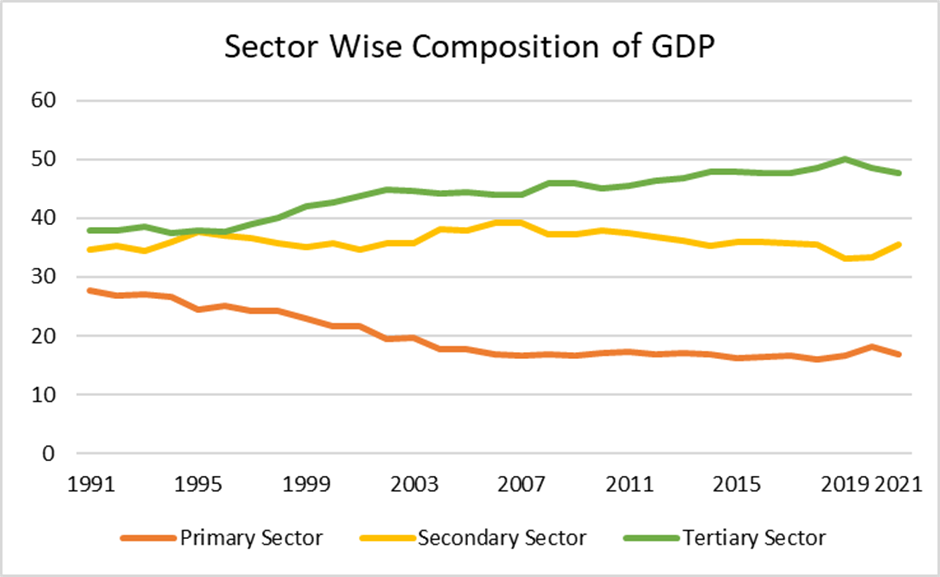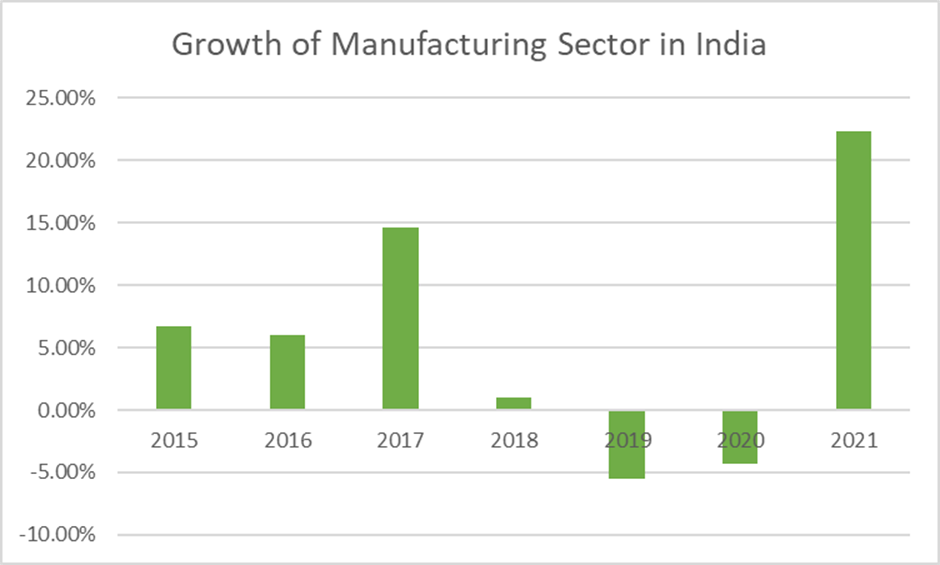In today’s world where technology changes with the blink of an eye, where modernization has reached new heights, and where technological advancements are inevitable, we can not ignore the contribution of the manufacturing sector towards the augmentation of the nation’s GDP.
For any country’s economy, the manufacturing sector acts as the bridge between primary and tertiary services. Apart from generating stable employment opportunities, the sovereign states’ economic upswing is scaled according to the growth in their manufacturing industries.
In Ricardo Hausmann and Cesar Hidalgo’s words, “productive capabilities are all the inputs, technologies and ideas that, in combination, determine the frontiers of what an economy can produce.” With the ever-increasing globalized world, manufacturing has been a key driver for high-valued blue-collar job creation. Concurrently, intertwined with core R&D, advanced production provides an important institutional foundation that is integral for a healthy economic boom. Since manufacturing paves the way for a non-tacit, well-codified innovation, the absence of the former can severely truncate the concoctive capabilities of the nation.

Source: World Bank
India is no exception. We, for a long time, have remained an agrarian economy. The year 1991 was a turning point for the service sector. Parallelly, the economists were quick to pin-point and blame the ignorance towards the manufacturing sector as the main basis for India’s slower growth standing among other developing states. It was not until recently that the Indian policymakers shifted their focus to the development of the secondary sector.

Source: World Bank
The graph above is a clear depiction that the nation, home to around 138 crore individuals, is yet to realize its potential as a manufacturing powerhouse. Nevertheless, it is certainly not a piece of cake. The journey to turn this dream into reality is not smooth as silk. Certain gigantic roadblocks await us on our journey toward achieving global manufacturing dominance. This includes:
1. Power availability: The major threat to Indian manufacturing is a dearth of power availability. Due to the unattainability of power 24 hours per day and uneven distribution of electricity supply, there is, consequently, a decline in productivity and efficiency, and output rates.
2. The factors of production: India is at the back front in assisting companies with the four indispensable factors needed for production- “land, labor, capital, and enterprise.” The industrial land here is one of the most expensive worldwide. Simultaneously, the cost of capital is 20%-30% higher than the world market. In addition to all this, the per unit labor contribution to the output is lesser in India than in many competing countries. All of this lowers our global competitiveness and puts us in a disadvantageous situation.
3. Logistics: The expenses for storing, acquiring, and transporting products to the end of the line is 13% of the revenue. This is 5% more than the global average costs.
4. R&D: The country’s expenditure on innovation and creative visualization is as low as 1.5% of its GDP. Overlooking the technology and quality aspect has cost us slower thriving and momentum in our economy.
5. Infrastructural woes: The poor network of roads and inadequate and undeveloped railway lines complemented with insufficient air and sea port capacities make transportation chaotic and inefficient.
Given such hindrances, the current leadership is strong-headed about fostering expansion in this sector through the implementation of laws that make it easier to start a business in the region. In accordance with this, “ Think Global, act local, serve global” has been the administration’s mantra over the past few years. Since 2014, one of the major initiatives undertaken by the government to transform India into a manufacturing hub includes the “Make in India” campaign. Launched in September 2014, it’s an umbrella plan of action that gives an impetus to the Indian production sector through the amalgamation of investment, innovation, skill development, and best-in-class manufacturing infrastructure. Under this, the government desired an environmentally sustainable path to prosperity. The four pillars that define it are:
New Processes: Under this, the scheme identified ease of doing business as the single most powerful tool to facilitate entrepreneurship across the nation. Within this, several de-licensing and de-regulating policies were launched to provide a business-friendly environment.
New Infrastructure: Both social and public infrastructural facilities are like oxygen for any nation’s economy. The program aimed to build industrial corridors, and smart cities through state-of-the-art technology. Furthermore, the government decided to undertake the upgradation of existing infrastructure through research and innovation.
New Sectors: With the growing interconnectedness, we can, but not ignore the significance of FDI (Foreign Direct Investments) for the development of the country. The program covered this aspect by inducing investment in several government-dominated sectors like defense production, railways, and construction infrastructure. Integrated web portals and professionally maintained brochures catalyzed the detailed information sharing on various incentives launched by the government in this regard.
New Mindset: The scheme envisaged the government as a facilitator and not a regulator of the private sector and partnered with them for maximizing economic benefits.
The policy is a collaborative effort of numerous union ministers, industry experts, and knowledge partners. The “ India mein Bana, Poore vishwa mein pahuncha” is the mantra that tied them together.
Furthermore, from 2020 onwards, almost any and every global occurrence has COVID-19 as its cause. This transition is no different. The pandemic resulted in colossal damage to global supply chains. The Indian policymakers saw this as a silver lining. With major corporations steering their manufacturing ship into the Indian sea, the leaders wish to keep them on board for a long time.
During the tumultuous “pandemic years”, the GoI announced the ‘AATMANIRBHAR BHARAT’ package, a comprehensive economic stimulus of INR 20 lakh crore, equivalent to almost 10% of India’s GDP on May 12, 2020. As the name suggests, the underlying rationale of the scheme is to make the country and the individuals self-reliant in all senses. The five tranches outlined under this scheme are- “Economy, Infrastructure, System, Demand and Vibrant Demography.”
Certain major institutional changes undertaken in this involve:
-
PPP dominance: For amplifying the private sector’s involvement, the ministries designed Public Private Partnership models. A full stop has been put to the government’s monopoly in coal and commercial mining. The private players are allowed to bid for coal blocks and undertake exploratory activities. Furthermore, a green flag is given to the private sector for using ISRO facilities and being part of future space travel plans. Additionally, under the aviation sector*, more airports have been put on auction on PPP mode. The FDI limit under the crucial defence sector has also been raised to 74% from the previous 49% limit.
-
Agricultural Infra: The government will put forth an amount of 1.5 lakh crore rupee for developing logistic support needed for farming and related activities.
-
Building smaller: Small businesses that had taken loans amounting to 50,000 rupees or less (under MUDRA-Shishu scheme) received a subsidy of 2% (on the interest) for the year 2021.
-
Uplifting every segment: The street vendors will also be able to avail easy credit which will allow them to receive 10,000 rupees as the initial working capital.
-
Ease of Doing business: The 2 key areas have been the focus of attention- ‘starting a business’ and ‘insolvency resolution.’ Certain direct key measures in this are lower penalties of defaults for small companies and startups and expansion of minimum threshold to initiate insolvency issues to rupees 1 crore.
It doesn’t end here. The announcement done in five tranches covers all integral stakeholders ranging from agriculture, MSMEs, big private players, and service sector. The administration has tried to cover all aspects of the spectrum and develop a roadmap for a dominant India.
Regardless of this, ‘Making mistakes is inevitable, learning from them is what matters.’ The same applies to the Indian leaders as well. Another opening to be the next biggest manufacturing hub and make “Made in India” products accessible in every corner of the world is right in front of us. What matters is overcoming the hiccups. Filling any gaps needs to be the prime focus of leaders.
Although, only time will tell whether these efforts will yield the desired result or not. After all, the future is ascertained!
References:
- India, G. o. (n.d.). Atmanirbhar Bharat Package. Retrieved October 25, 2022, from https://www.indiabudget.gov.in/anbp/
- India, G. o. (2014, September 25). ABOUT US. Make In India. Retrieved October 25, 2022, from https://www.makeinindia.com/about
- India, G. o. (2020, August 14). Aatmanirbharbharat. Retrieved October 25, 2022, from https://aatmanirbharbharat.mygov.in/

